The Microsoft Surface Laptop 4 15-Inch Review: Refreshing Ryzen
by Brett Howse on May 6, 2021 8:00 AM ESTDisplay Analysis
One area where Microsoft has really focused on is displays, basically since the Surface Pro 4 and Surface Book launched back in 2016. Since that time, they are one of the very few manufacturers to hardware calibrate every display at the factory. Microsoft has also embraced the 3:2 aspect ratio across the entire Surface lineup, from the diminutive Surface Go, all the way up to the 28.5-inch Surface Studio. On notebook computers, the extra height offered by the taller screen provides a better workflow for most tasks, although it does increase the letterboxing for viewing media that is delivered in 16:9.
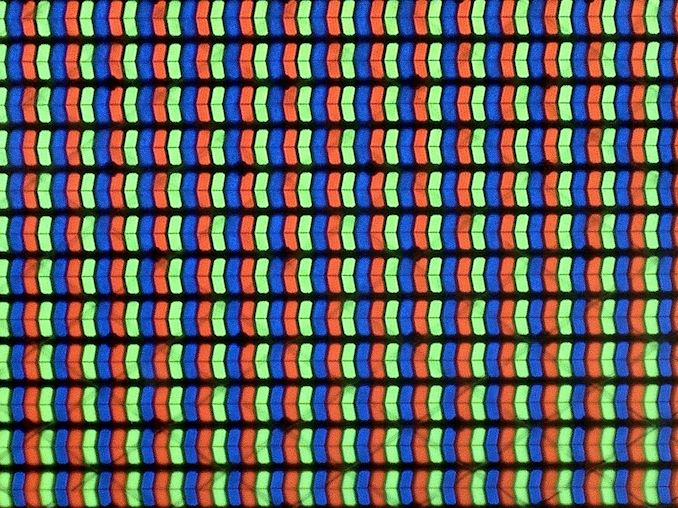 Surface Laptop 4 Subpixel Arrangement
Surface Laptop 4 Subpixel Arrangement
Although there have been some devices pushing display technology more quickly than Microsoft, it is not always for the benefit of all users all the time. Microsoft has stuck with sRGB gamut displays, when many competitors offer displays with the wider gamut P3-D65 support, or Adobe RGB. Some displays offer Dolby Vision, and some offer HDR, but sadly, none of those technologies make PC displays better all the time.
As I have discussed many times in the past, Windows 10 lacks proper color management support for the entire display pipeline, and as such, moving away from the expected sRGB color gamut on the PC is a challenge, and can result in many unwanted repercussions. Applications must explicitly support wide-gamut color, and since most do not, the experience is less than ideal. While it would be nice for the Surface team to address this, to this point, they have not. So, for today, sRGB is the best choice for most of the people, most of the time.
The 3:2 display on the Surface Laptop 4 offers a resolution of 2496x1664 pixels, which works out to 201 pixels per inch. It can’t match the 260 pixels per inch of the much more expensive Surface Book, but the display density is a nice compromise between clarity, cost, and performance. Microsoft also includes two color profiles, with sRGB, and Enhanced, which tweaks the colors to be a bit more vivid, although at the cost of accuracy. Most people will likely prefer this option though.
To test the display characteristics, we use Portrait Displays Calman software with a custom workflow. For brightness and contrast measurements, we use the X-Rite i1Display Pro colorimeter, and for color accuracy testing, we use the X-Rite i1 Pro2 spectrophotometer.
Brightness and Contrast
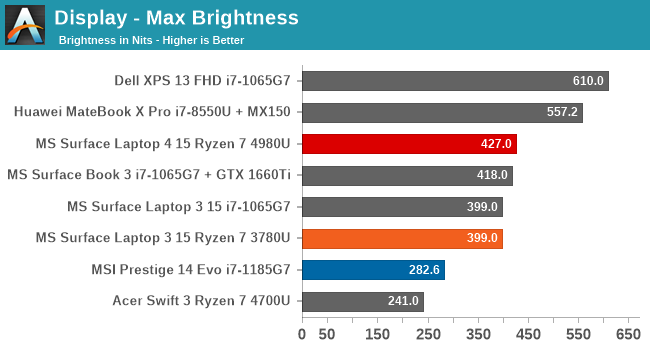
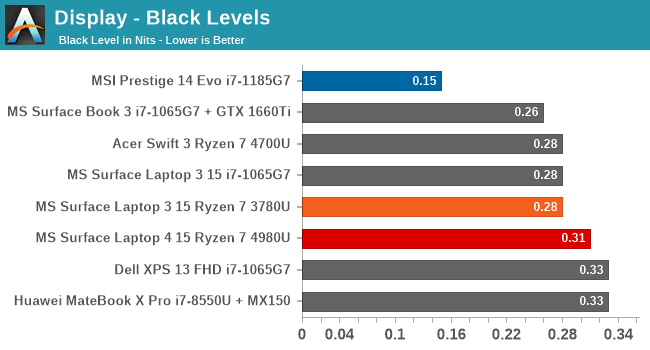
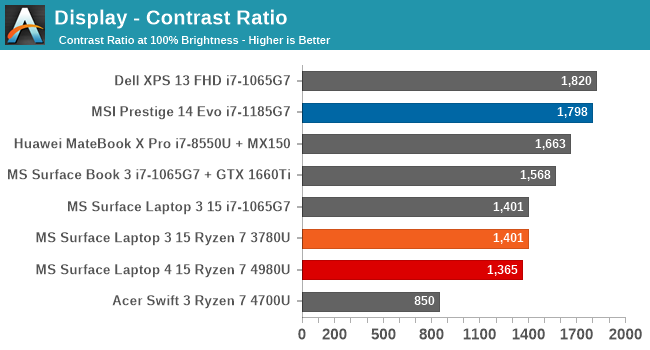
At 427 nits, the Surface Laptop 4 gets quite bright, although it is nowhere near the Dell XPS 13, and the Dell also has one of the best anti-reflective coatings in the PC space, making it a superior device for outdoor use. But there is still plenty of brightness for most use cases. Black levels are good, but the overall contrast ratio can not match the best displays on the market, which is a shame. The display goes all the way down to 6.7 nits, so the brightness range is quite wide.
Grayscale
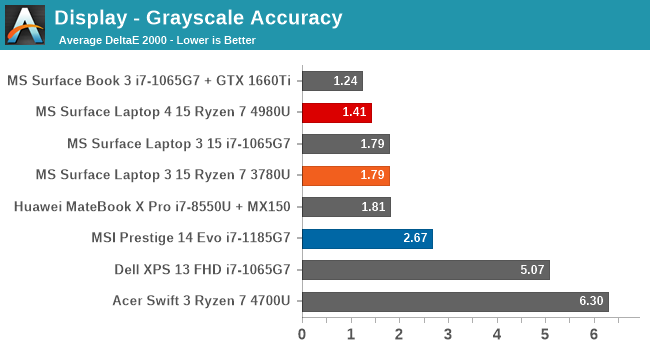
With years of experience calibrating every display panel they offer; it is no surprise to see the Surface Laptop 4 results having excellent accuracy. Grayscale is one area that can be tightened up with a custom ICC profile, but it is really not needed when purchasing a Surface device, as they are all good out of the box.
Gamut Accuracy

Color accuracy at the 100% levels for the primary and secondary colors is spot on with this device.
Saturation
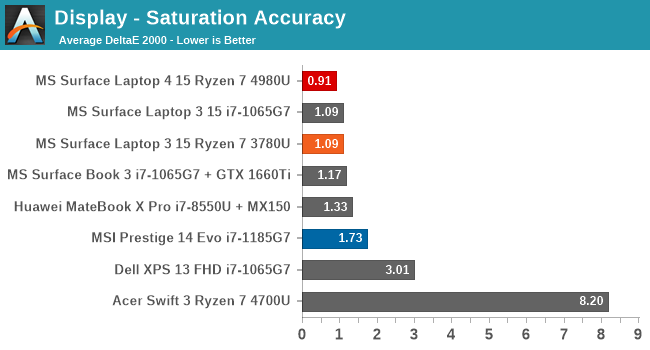
Unlike the Gamut test where the primary and secondary colors are tested at the 100% levels, the saturation test increases the test points to 4-bit steps from 0-100%. Again, the Surface Laptop 4 is superb here.
Gretag Macbeth
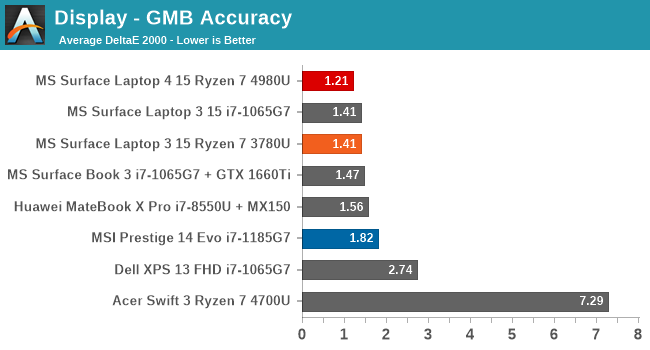
The final test moves away from just testing the primary and secondary color axis, and tests colors from across the spectrum, including the important skin tones. The results are excellent, again. No single color even hits the 3.0 error level.
Colorchecker
The final image is the relative colorchecker, where the target color is on the bottom of the swatch, and the displayed color is on the top. The error levels are almost imperceptible to the human eye, and showcases the reason why factory calibrating the display is so valuable.
Display Conclusion
Although the Surface Laptop 4 does not offer the current display buzzwords of HDR, Dolby Vision, or DCI-P3 gamut (which is technically an incorrect term on the PC, but does not stop the marketing departments from using it) the Surface Laptop 4, as usual with a Surface device, delivers some of the most accurate colors of any device out of the box.
If you want a device to edit photos or videos, having an accurate display can be critical to your workflow, and this is where the Surface lineup really shines. With every generation, and every price point, every Surface device offers a very solid display, and is one of the best reasons to consider one. The 3:2 aspect ratio is also a win for productivity tasks, especially compared to 16:9 devices.


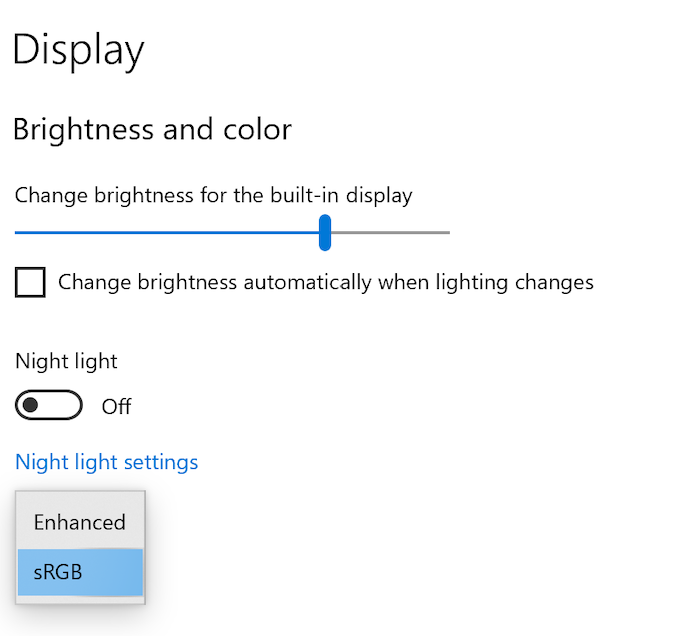













98 Comments
View All Comments
richardshannon77 - Monday, May 10, 2021 - link
I've been working at home for the past year using a grand total of 0 type-A ports on my laptop. I have a type-C connection to a type-C dock and a type-A BT dongle attached to that for my mouse. I suspect that this is along the lines of what the gods of technological advancement had in mind. At this point, it's type-C for the win. Although, I can't figure out where to put my 3.5" floppies :/saratoga4 - Thursday, May 6, 2021 - link
Perfectly fine to have 1 USB-C port, but since its used for charging there should be at least two other ports. Doesn't matter what they are, just give me the ability to have a thumb drive and mouse while charging.This is something the (much smaller) Dell XPS 13 devices do a lot better. My older model has charging, 2x USB and TB. They apparently had so much space left over they even threw in an SD card slot. A 15" laptop shouldn't have so much less.
s.yu - Sunday, May 9, 2021 - link
For a second I thought that was an iPP there. Turns out there's 1A, 1C and the headphone jack, that's bad but not unusable.Kevin G - Thursday, May 6, 2021 - link
I think you're looking at it backwards as computer manufacturers have learned one thing: consumers will continue to buy products they don't like if there are no alternatives at the prices they want. Consumers have given up fighting as pricing has become the dominant factor and people don't want to spend more, especially in a market whose pricing has been slowly creeping up of late.The reduction of the number of ports historically has made sense for the most part: USB has won out. However with Type-C that can also carry power, things do get more complicated as you can lose a data port for a peripheral when you need to charge the unit. Devices that only have two USB ports feel anemic in this regard as users do notice when they'll have to pull double duty in a crunch.
Alistair - Thursday, May 6, 2021 - link
Some of what you said makes sense. But removeable batteries and storage are next level, not USB port level priorities. Come On. Apple charges $800 for 1TB storage that I can buy for $100 to add to the Surface. Bam, I'm interested in the Surface. Because my phone lacks a removeable battery, I generally upgrade every 24 months as the phone won't last. Removeable batteries enable 3 and 4 year ownership. These are not "USB port" level myopia.Kamen Rider Blade - Friday, May 7, 2021 - link
The point is that Renoir offers more ports internally on it's SoC.1x USB 3.2 Gen1 Type-C
5x USB 3.2 Gen1 Type-A
2x USB 2.0 Type-A
That's what is natively available, why not implement all of those USB ports?
MS doesn't want to maximize the features or ports on Renoir, that's their choice.
But to the end user, it's cheapening out on features that are available on the SoC and not used.
grant3 - Tuesday, May 11, 2021 - link
Your guarantee is now broken: I would buy a surface laptop if they included a single additional thunderbolt port.You're probably right that -many- people do not care about ports, but that is changing quickly as people set up their work-from-home hardware and start to realize how damn vital having a hub to connect their monitors and other peripherals is.
Apple, Dell, and other makers got the memo years ago. They give their premium 15" laptops at least 3+ ports. Microsoft apparently thinks it can replicate Apple's "Remove features and raise the price" approach to hardware success, but haven't clued into the fact that it only works when they simultaneously offer -some- compelling alternative to the hardware they removed.
Eletriarnation - Thursday, May 6, 2021 - link
They could have rearranged the layout and added to the BoM cost to get in a second Type-A port which probably >95% of the user base won't ever need. Or, they could tell that <5% to buy a hub and deal with it.drothgery - Thursday, May 6, 2021 - link
Lots of people use external devices; I've got a TB3/USB-C dock that I connect my home or work laptop to that's chained to a monitor, keyboard, mouse, power, and wired internet.Pretty much no one uses optical media on laptops (or desktops, to be honest), which is why you have to use an external drive for it even on big clunky gaming laptops.
Calin - Friday, May 7, 2021 - link
The volume and weight of an optical disk for laptops compares to a 48Wh battery.You could easily fit one more 2.5 inch SATA SSD _and_ another 20Wh of battery inside that, or SSD plus one M2 plus on SODIMM, and so on.
Even if 17" gaming laptops are huge, their internal space is at a premium due to the cooling necessary for the CPU and GPU. In this case, the volume and weight of the optical drives give you another 20% cooling capacity.
One of my university colleagues had a computer (in a tower case) with a CD drive (650 MB) and a 420MB hard drive. Even if that would have been a laptop, losing so much volume to removable media larger than the hard drive would have been a win.
Not so much for the present - 9GB double side double density DVDs or 50GB BluRays do not compare well to even 256GB SSD of the low end devices.